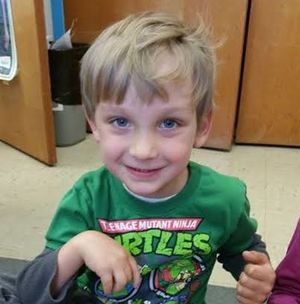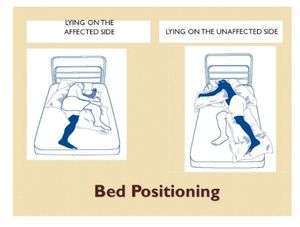Infantile Hemiplegia
Introduction[edit | edit source]
Infantile hemiplegia refers to brain injuries that occur before(pre natal) or at birth that lead to hemiplegia/ total paralysis of one side of the body, including the face, arm and leg..[1] It occur in infancy and is usually caused by a vascular accident such as cerebral infarction or thrombosis; frequently associated with seizures. Infantile hemiplegia is a rare condition of the nervous system that usually appears in children prior to the age of 4[2]. Hemiparesis/hemiplegia though rare in children is a cause of significant mortality and morbidity. Infections continue to be important cause of neurodeficit, at least in the developing countries.[3]
Etiology[edit | edit source]
- CNS infection (e.g encephalitis, meningitis and abscess)
2. Neoplastic intracranial space occupying lesion(ICSOL)
3. Trauma
4. Developmental anomalies of the brain.[3]
5. Congenital Heart disease
6. Purulent venous Thrombosis
7. Sickle Cell anemia
8. Homocysteinuria[4]
Clinical features[edit | edit source]
- Pain-
- Muscle spasms
- Difficulty in gait and balance
- Emotion-depression
- Hemiplegia-The hemiplegic element usually affects the arm, leg, and face, with the arm always affected to a greater degree than the leg and face. The weakness is usually of a spastic type, and in most cases the arm assumes a typical posture of adduction at the shoulder and flexion at the elbow and wrist[5].
- Epilepsy-Epilepsy convulsions occur in the major in the majority of cases; these are often focal and of the Jacksonian type, but generalized seizures, psychomotor equivalents, and petit mal, have all been observed. Epilepsy is one of the most common and distressing symptoms is the occurrence of convulsive seizures[5].
- Mental Changes-Changes in mentality has led the parents to seek advice. The mental changes cover a wide range from virtual imbecility at the one extreme, to the mildest retardation at the other, but this is often associated with an asocial outlook, which may well be related to the convulsive episodes[5].
Ranges of problems which may affect movement ability[edit | edit source]
- Persistent posturing and patterning movements
- Stiffness of movements of several types
- Floppiness and weakness
- Limited useful range of movement
- Intellectual difficulties and/or motivation
- Central sensory deficits
- Epilepsy
Diagnosis[edit | edit source]
Complete blood count
Blood biochemistry test.
Cranial CT
Cranial MRI
Electroencephalogram(EEG)
Doppler ultrasound[5]
Management[edit | edit source]
(a) Conventional therapies ( Therapeutic Exercises, Traditional Functional Retraining)
- Range of motion Exercises
- Muscle Stretching Exercises
- Splinting
- fitness training
- Compensatory Techniques.[6]
(b) Bed positioning;
Lying on the affected side;
- one or two pillows for head
- affected shoulder positioned comfortably.
- Place unaffected leg forward on one or two pillows.
- Place pillows in front or behind to give support[7].
Lying on unaffected side
- One or two pillow for the head
- Affected arm forward and supported on pillow(s)
- Affected leg backwards on one or two pillows
- Place pillows behind.[7]
(c) Neurofacilitatory techniques such as
- Bobath: it is an approach that focuses to control responses from damaged postural reflex mechanism. Emphasis is placed on affected inputs facilitation and normal movement patterns.
- Rood: Emphasize the use of activities in developmental sequences, sensation stimulation and muscle work classification. Cutaneous stimuli such as icing, tapping and brushing are employed to facilitate activities.
- Proprioceptive neuromuscular facilitation(PNF): they advocated the use of peripheral inputs as stretch and resisted movement to reinforce existing motor response. Total patterns of movement are used in treatment and are followed in a developmental sequence. [6]
(d) [7]Learning theory approach such as
- conductive education
- motor relearning theory: it emphasizes the practice of functional tasks and importance of relearning real-life activities for patients. Principles of learning and biomechanical analysis of movements and tasks are important.
- [7]Biofeedback: it is a modality that facilitates the cognizant of electromyographic activity in selected muscle or awareness of joint position sense via visual or auditory cues.
(e) Functional Electrical stimulation
this is a modality that applied a short burst of electrical current to hemiplegic muscle or nerve. It reduces spasticity in hemiplegic patient.
(f) [6]Conventional Gait training:
Conventional gait training has focused on part-practice of components of gait in preparation for walking. Includes
- Symmetrical weight bearing training
- Weight shifting
- Stepping training(swinging/clearance)
- Heel strike
- Single leg standing
- Push off/ Calf rise. Followed by,
Circuit training (reaching in sitting and standing, sit-to-stand, step-ups, heel lifts, isokinetic strengthening, walking over obstacles, up and down slopes.
References[edit | edit source]
- ↑ Syed G, Benni D, Naik SV, Surendra P. Infantile hemiplegia in pediatric dental set-up. Dental research journal. 2012 Sep;9(5):651
- ↑ MEDIGOO. available from: www.medigoo.com/articles/infantile-hemiplegia/
- ↑ 3.0 3.1 Chinnabhandar V, Singh A, Mandal A, Parmar BJ. Acute hemiplegia in children: A prospective study of etiology, clinical presentation, and outcome from Western India. Journal of neurosciences in rural practice. 2018 oct;9(4):504.
- ↑ Golden GS. Strokes in Children and adolescents. Stroke. 1978 Mar;9(2):169-71.
- ↑ 5.0 5.1 5.2 5.3 Krynauw RA. Infantile hemiplegia treated by removing one cerebral hemisphere. Journal of neurology, neurosurgery, and psychiatry. 1950 Nov;13(4):243.
- ↑ 6.0 6.1 6.2 Physiopedia. available from: www.physio-pedia.com/HEMIPLEGIA
- ↑ 7.0 7.1 7.2 7.3 mobile physiotherapy clinic available from. www.mobilephysiotherapyclinic.in/physiotherapy-management-of-hemiplegia/








